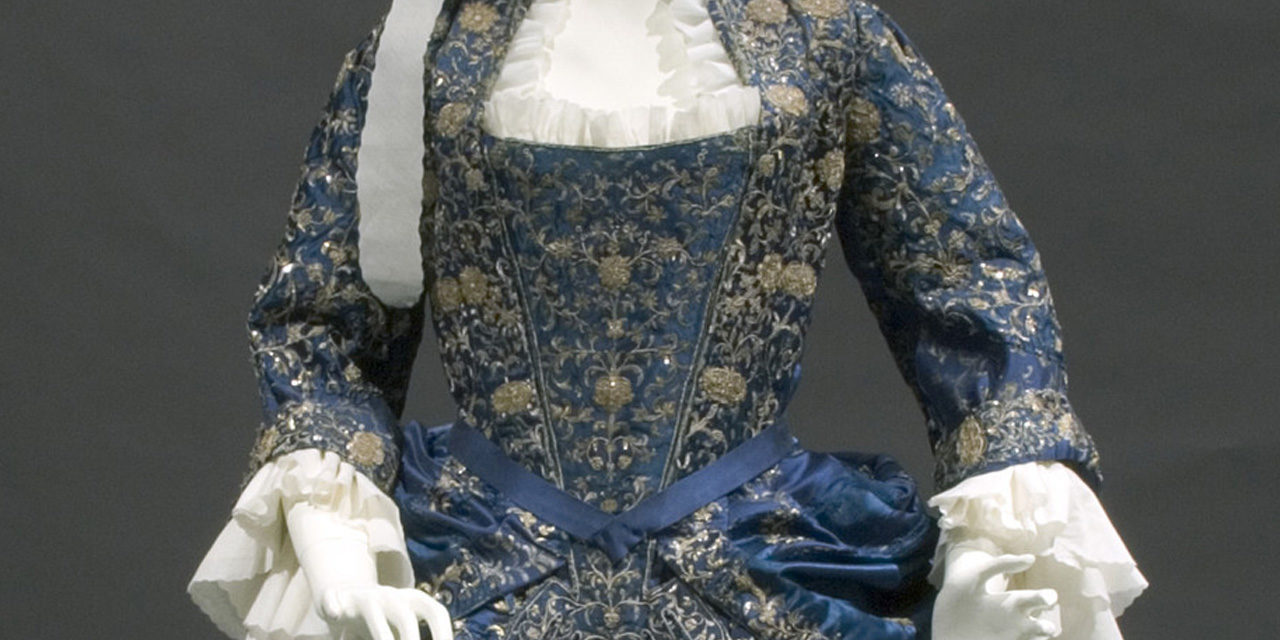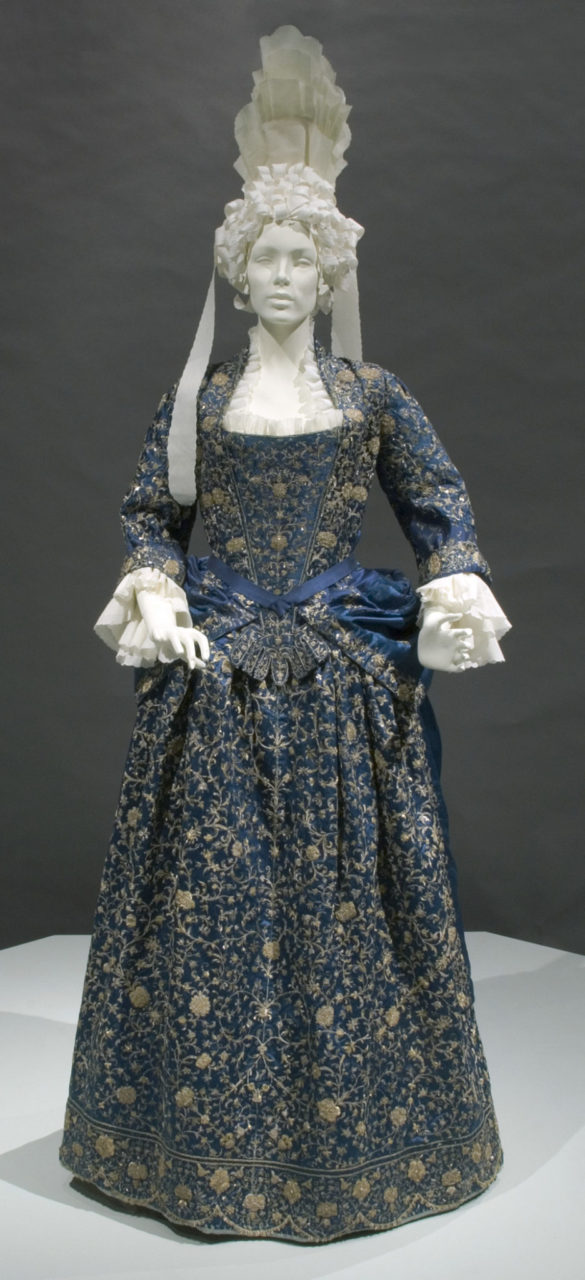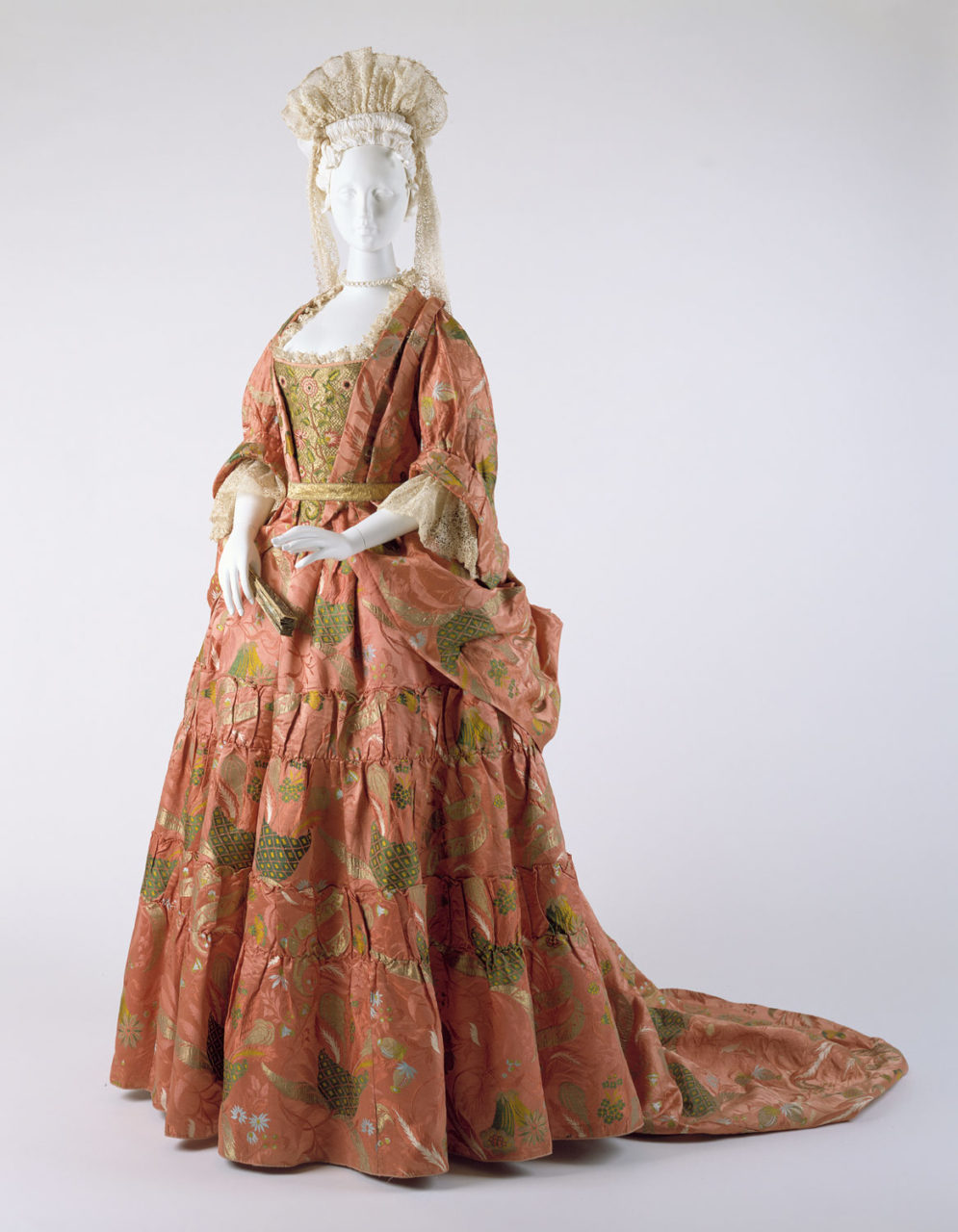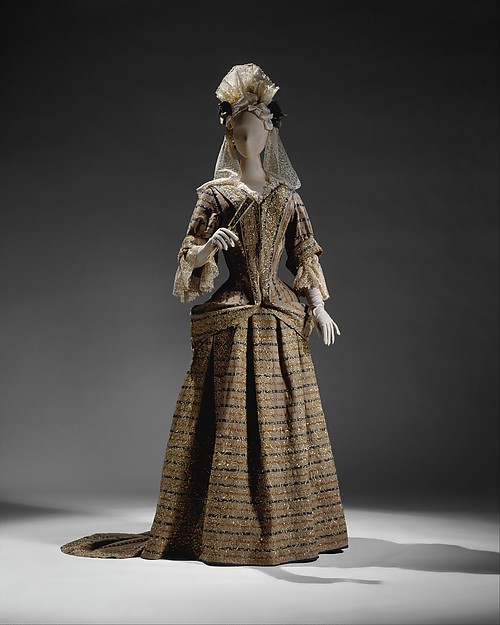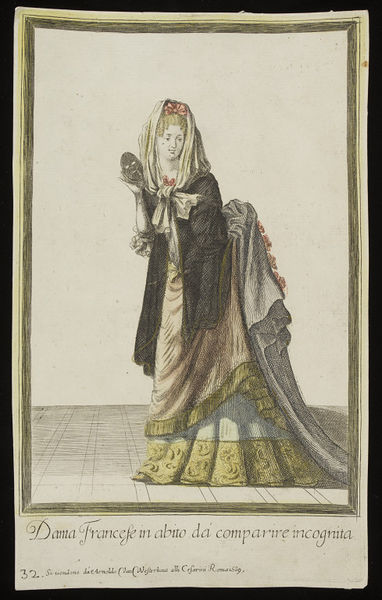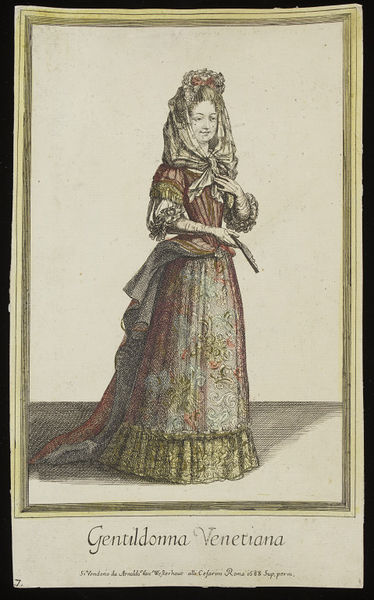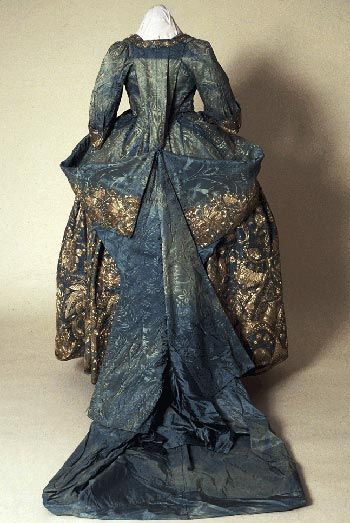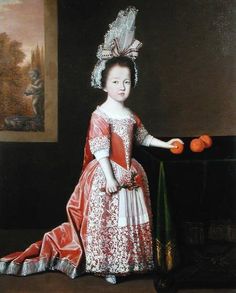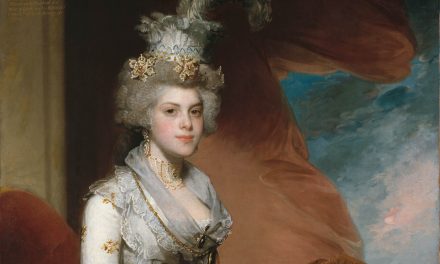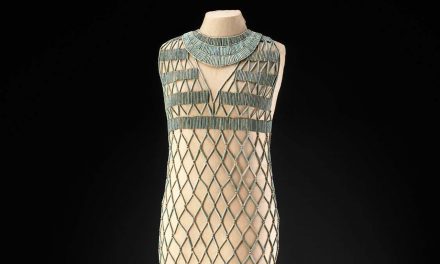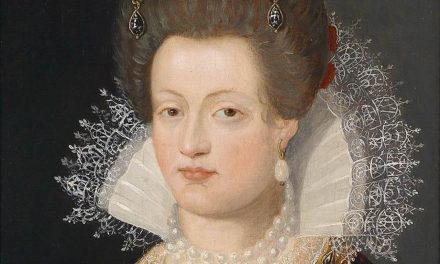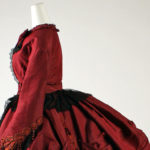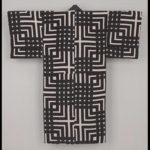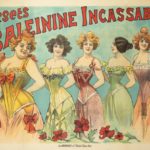A jacket-like bodice with pulled back overskirt that bustled in the back, often in elaborately patterned fabric, first worn in the 17th century.
The Details
Calasibetta in Fairchild’s Dictionary of Fashion (1998) defines a mantua as a:
“woman’s overdress or gown worn over an underskirt. Made with a loosely fitted unboned bodice joined to overskirt with long train. The overskirt was split in front to expose petticoat. Worn on social or formal occasions from mid-17th to mid-18th century.”
Wikipedia describes the mantua, writing:
“developed into a draped and pleated dress and eventually evolved into a dress worn looped and draped up over a contrasting petticoat and a stomacher. The mantua-and-stomacher resulted in a high, square neckline in contrast to the broad, off-the-shoulder neckline previously in fashion. The new look was both more modest and covered-up than previous fashions and decidedly fussy, with bows, frills, ribbons, and other trim, but the short string of pearls and pearl earrings or eardrops worn since the 1630s remained popular.
The mantua, made from a single length of fabric pleated to fit with a long train, was ideal for showing the designs of the new elaborately patterned silks that replaced the solid-colored satins popular in mid-century.”
Elizabeth Lewandowski in The Complete Costume Dictionary (2011) defines a mantua as:
“Early Georgian (1700-1750). Formal gown with formerly drapery in the back. Worn over boned bodice and with elaborate skirt. Popular in the United Kingdom longer than elsewhere.” (186)
Fig. 1 - Designer unknown (Italian). Woman's mantua with stomacher and petticoat, ca. 1700. Silk satin with gold- and silver-metallic thread embroidery; a) dress: center back length: 56 in. (142.2 cm); b) petticoat: center front length: 35 in. (88.9 cm). Los Angeles: Los Angeles County Museum of Art, M.88.39a-c. Costume Council Fund. Source: LACMA
Fig. 2 - Maker unknown (British). Mantua, 1708. Silk and metal. New York: Metropolitan Museum of Art, 1991.6.1a, b. Purchase, Rogers Fund, Isabel Shults Fund and Irene Lewisohn Bequest, 1991. Source: The Met
Fig. 3 - Designer unknown (British). Mantua, 1707. Silk and metal. New York: The Metropolitan Museum of Art, 1991.6.1a, b. Purchase, Rogers Fund, Isabel Shults Fund and Irene Lewisohn Bequest, 1991. Source: The Met
Fig. 4 - Maker unknown (British). Mantua, Late 17th Century. Wool and metal thread. New York: The Metropolitan Museum of Art, 33.54a, b. Rogers Fund, 1933. Source: The Met
Fig. 5 - Arnold van Westerhout (Italian, 1651 - 1725). Dama Francese vestita da Sultana con la ventarola, 1689. Engraving; hand-colouring;printing ink; watercolour. London: Victoria and Albert Museum, E.21583-1957. Given by the House of Worth. Source: Victoria and Albert Museum
Fig. 6 - Arnold van Westerhout (Italian, 1651 - 1725). Dama Francese in Abito da Comparire Incognita, 1689. Engraving; hand-colouring;printing ink; watercolour. London: Victoria and Albert Museum, E.21582-1957. Given by the House of Worth. Source: Victoria and Albert Museum
In the Illustrated Encyclopedia of Costume and Fashion(1550-1920) Jack Cassin-Scott states that the mantua-style gown:
“was basically an open robe, but worn with a petticoat. The close-fitting, long waisted bodice was unboned and shaped to the underlying corset. The corset, replacing the stomacher, could have been embroidered or plain in the front. The close fitting sleeves ended just below the elbow with turned up cuffs; the chemise sleeve and ruffle edged in lace appeared below. The petticoat was worn over a structure called the capula, or bell hoop, made of distended hoops of whalebone or cane.” (60)
In the Survey of Historic Costume (1998) Tortora and Eubank explain the mantua’s origins:
“mantua is thought to derive from the form of middle eastern robes which were imported into Europe. The resulting garment, however, was quite different from its supposed ancestor. Full in both back and front, the garment was worn over a corset and a underskirt. For casual wear it was loose (this style is thought to have originated to provided a less confining costume for women), but for more formal wear, it was pleated to fit the body at front and back and belt. Front skirts edges were sometimes pulled to the back and fastened to form a drape effect.” (216)
In addition the Encyclopedia of Clothing and Fashion explains the enduring legacy of the mantua on later fashion:
“The pulled-back overskirts of late-seventeenth and early-eighteenth-century mantuas (loose-fitting gowns) emphasized this area, and pads or “cork rumps” sometimes supported the swagged-up styles of the late 1770s and 1780s.” (204)
Fig. 7 - Arnold van Westerhout (Italian, 1651 - 1725). Gentildonna Venetiana, 1688. Engraving; hand-colouring;printing ink; watercolour. London: Victoria and Albert Museum, E.21581-1957. Given by the House of Worth. Source: Victoria and Albert Museum
Fig. 8 - Artist unknown. Comtesse de Mailly, 1698. Private Collection. Source: Wikipedia
Fig. 9 - Designer unknown. Silver Embroidered Blue Damask Court Mantua, 1730-40. Newport: Tredegar House. Source: National Museum Wales
Fig. 10 - Artist unknown. Child Wearing a Court Mantua, 17th Century. Private Collection. Source: Pinterest
References:
- Calasibetta, Charlotte Mankey. Fairchild’s Dictionary of Fashion. 2nd ed. New York: Fairchild Publications, 1988. http://www.worldcat.org/oclc/759888998.
- Cassin-Scott, Jack. The Illustrated Encyclopaedia of Costume and Fashion, 1550-1920. Poole, NY: Blandford Press, 1986. http://www.worldcat.org/oclc/636120194.
- Haugland, H. Kristina. “Bustle.” Encyclopedia of Clothing and Fashion. Ed. Valerie Steele. Vol. 1. Detroit: Charles Scribner’s Sons, 2005. 204-206. Gale Virtual Reference Library. Web. 5 Oct. 2016. http://libproxy.fitsuny.edu:2200/ps/retrieve.do?tabID=T003&resultListType=RESULT_LIST&searchId=R2&searchType=BasicSearchForm¤tPosition=1&userGroupName=fitsuny&inPS=true&sort=RELEVANCE&contentSegment=&prodId=GVRL&contentSet=GALE%7CCX3427500101&&docId=GALE%7CCX3427500101&docType=GALE#
- Lewandowski, Elizabeth J. The Complete Costume Dictionary. Lanham, MD: Scarecrow Press, 2011. http://www.worldcat.org/oclc/788995672.
- Tortora, Phyllis G., and Keith Eubank. Survey of Historic Costume: A History of Western Dress. 3rd ed. New York: Fairchild Publications, 1998. http://www.worldcat.org/oclc/39154857.
-
“Mantua (Clothing).” Wikipedia, June 24, 2017. https://en.wikipedia.org/w/index.php?title=Mantua_(clothing)&oldid=787217830.

